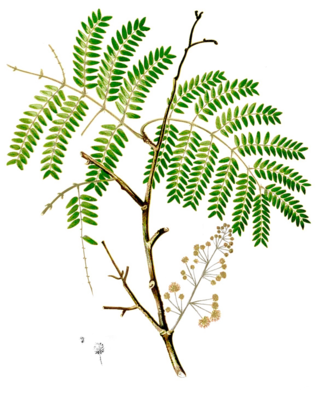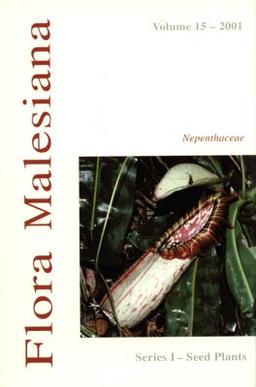Related Research Articles

The Mimosoideae are a traditional subfamily of trees, herbs, lianas, and shrubs in the pea family (Fabaceae) that mostly grow in tropical and subtropical climates. They are typically characterized by having radially symmetric flowers, with petals that are twice divided (valvate) in bud and with numerous showy, prominent stamens.

The Fabaceae or Leguminosae, commonly known as the legume, pea, or bean family, are a large and agriculturally important family of flowering plants. It includes trees, shrubs, and perennial or annual herbaceous plants, which are easily recognized by their fruit (legume) and their compound, stipulate leaves. The family is widely distributed, and is the third-largest land plant family in number of species, behind only the Orchidaceae and Asteraceae, with about 765 genera and nearly 20,000 known species.
The Cronquist system is a taxonomic classification system of flowering plants. It was developed by Arthur Cronquist in a series of monographs and texts, including The Evolution and Classification of Flowering Plants and An Integrated System of Classification of Flowering Plants (1981).

Ornithogalum is a genus of perennial plants mostly native to southern Europe and southern Africa belonging to the family Asparagaceae. Some species are native to other areas such as the Caucasus. Growing from a bulb, species have linear basal leaves and a slender stalk, up to 30 cm tall, bearing clusters of typically white star-shaped flowers, often striped with green. The common name of the genus, star-of-Bethlehem, is based on its star-shaped flowers, after the Star of Bethlehem that appears in the biblical account of the birth of Jesus. The number of species has varied considerably, depending on authority, from 50 to 300.

Acacia, commonly known as the wattles or acacias, is a large genus of shrubs and trees in the subfamily Mimosoideae of the pea family Fabaceae. Initially, it comprised a group of plant species native to Africa and Australasia. The genus name is Neo-Latin, borrowed from the Greek ἀκακία, a term used by Dioscorides for a preparation extracted from the leaves and fruit pods of Vachellia nilotica, the original type of the genus. In his Pinax (1623), Gaspard Bauhin mentioned the Greek ἀκακία from Dioscorides as the origin of the Latin name.
The Kubitzki system is a system of plant taxonomy devised by Klaus Kubitzki, and is the product of an ongoing survey of vascular plants, entitled The Families and Genera of Vascular Plants, and extending to 15 volumes in 2018. The survey, in the form of an encyclopedia, is important as a comprehensive, multivolume treatment of the vascular plants, with keys to and descriptions of all families and genera, mostly by specialists in those groups. The Kubitzki system served as the basis for classification in Mabberley's Plant-Book, a dictionary of the vascular plants. Mabberley states, in his Introduction on page xi of the 2008 edition, that the Kubitzki system "has remained the standard to which other literature is compared".

A taxonomic system, the Bentham & Hooker system for seed plants, was published in Bentham and Hooker's Genera plantarum ad exemplaria imprimis in herbariis kewensibus servata definita in three volumes between 1862 and 1883.
A system of plant taxonomy, the Goldberg system was published in:
A system of plant taxonomy, the Bessey system was published by Charles Bessey in 1915.

Matthew Hilary Peter Jebb is an Irish botanist and taxonomist specialising in the ant plant genera Squamellaria, Myrmecodia, Hydnophytum, Myrmephytum and Anthorrhiza, as well as the carnivorous plant genus Nepenthes.

Senegalia rugata is a spiny climbing shrub native to China and tropical Asia, common in the warm plains of central and south India. It is renowned as a raw material for shampoo, and the leaves and young shoots are often eaten. Archaeobotanical evidence shows its use for hair care in the pre-Harrapan levels of Banawali, some 4500–4300 years ago.
Mary Douglas Tindale was an Australia Australian botanist. She was an Australian botanist specialising in pteridology (ferns) and the genera Acacia and Glycine. She devoted her life to the study of ferns, and her name is widely associated with the group of flowerless plants.
The Melchior system, "a reference in all taxonomic courses", is a classification system detailing the taxonomic system of the Angiospermae according to A. Engler's Syllabus der Pflanzenfamilien (1964), also known as "modified or updated" Engler system.

Ficus pleurocarpa, commonly known as the banana fig, karpe fig or gabi fig, is a fig that is endemic to the wet tropical rainforests of northeastern Queensland, Australia. It has characteristic ribbed orange and red cylindrical syconia. It begins life as a hemiepiphyte, later becoming a tree up to 25 m (82 ft) tall. F. pleurocarpa is one of the few figs known to be pollinated by more than one species of fig wasp.

Falcataria is a genus of flowering plants in the family Fabaceae. It belongs to the monophyletic Mimosoid clade in the subfamily Caesalpinioideae. The genus has three species previously classified in the Falcataria section of the genus Paraserianthes by I.C. Neilsen. The distribution of these closely related species within the genus Falcataria links the wet tropics of north-east Australia to New Guinea, the Moluccas, Bismarck Archipelago, and the Solomon Islands east of Wallace's line similar to other plant taxa from the region.

"Nepenthaceae" is a monograph by Martin Cheek and Matthew Jebb on the tropical pitcher plants of Malesia, which encompasses Brunei, Indonesia, Malaysia, Papua New Guinea, the Philippines, and Singapore. It was published in 2001 by the National Herbarium of the Netherlands as the fifteenth volume of the Flora Malesiana series. The species descriptions presented in the monograph are based on the authors' field observations in Borneo, New Guinea, and Peninsular Malaysia, as well as the examination of plant material deposited at 20 herbaria.
Harmsiopanax ingens of the Gensing, or Ivy Family (Araliaceae), is a very spiney palmlike mesocaul tree endemic to the montane rainforests of central New Guinea which bears a terminal rosette of deeply lobed, meter-wide dentate margined, peltate leaves, maple-like in shape, on equally long petioles. It ultimately attains a height of eighteen meters, at which point it bears a huge panicle of flowers five meters high and equally wide; the largest above ground inflorescence of any dicot plant (although Caloncoba flagelliflora and Ficus geocarpa and Ficus unciata var. strigosa have larger subsurface panicles, each about nine meters in length. H. ingens' panicles are very unusual; the ultimate twigs being spikes each bearing about fifty tiny umbels, each umbel with 8 to 20 minute flowers. So panicle, spike and umbel are all represented in a single inflorescence. Harmsiopanax ingens is monocarpic, and again the largest such plant among dicots. H. ingens was discovered in 1973 by W. R. Philipson. Its native name is "makua".

Sarcotoechia is a genus of tropical rainforest trees, constituting part of the plant family Sapindaceae.
Flora of Thailand is a multi-volume flora describing the vascular plants of Thailand, published by the Forest Herbarium, Royal Forest Department since the 1970s. It currently consists of 12 volumes.
Flore du Cambodge, du Laos et du Viêtnam is a multi-volume flora describing the vascular plants of Cambodia, Laos, and Vietnam, published by the National Museum of Natural History in Paris since the 1960s. It currently consists of 35 volumes.
References
- ↑ Roos, M.C.; Hovenkamp, P. (30 October 2009). "Flora Malesiana in the coming decade". Blumea - Biodiversity, Evolution and Biogeography of Plants. 54 (1): 3–5. doi:10.3767/000651909X475860.
- ↑ "Flora Malesiana :: Meetings". floramalesiana.org. Archived from the original on 2011-01-08.